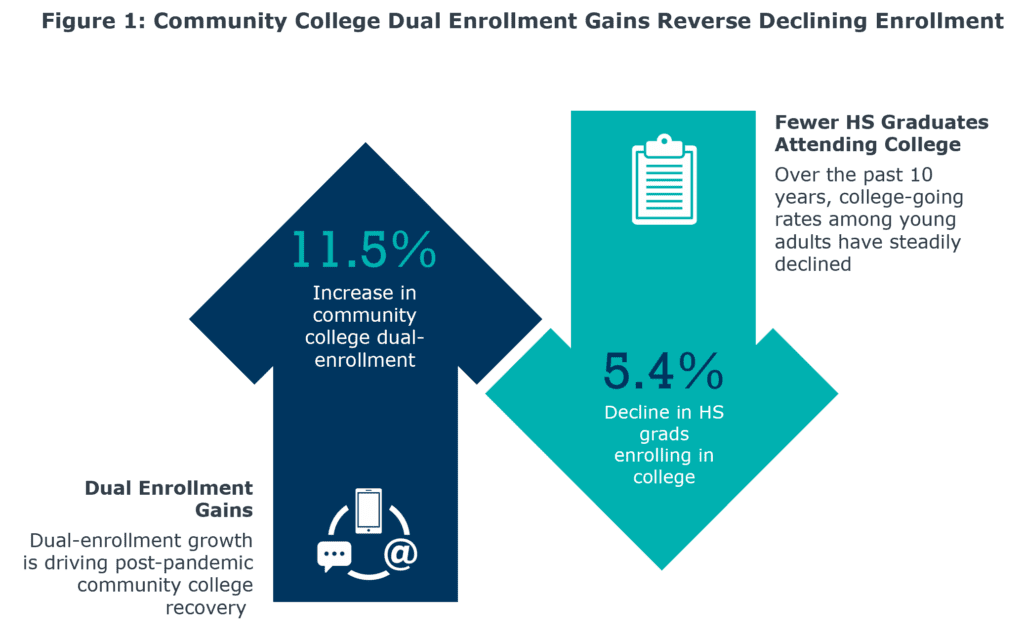Top 5 priorities for community college leaders in 2024
January 25, 2024, By Allison Peeler, LMSW, Associate Director, Product Marketing
Based on our Office Hours with EAB podcast, Episode 175, Top Priorities for Community Colleges in 2024
Follow the podcast on Spotify, Google Podcasts, Apple Podcasts, and SoundCloud, or visit our podcast homepage for additional episodes.
As I reflect on the many conversations I’ve had with campus leaders in the past year as part of EAB’s community college team, it’s clear to me that market competition, heightened complexity of student needs and expectations, and shifting perceptions of the value of college have significantly reshaped the landscape. Stepping into 2024, leaders must establish clear priorities to navigate this evolving terrain.
In this blog post, we’ll explore the five most urgent priorities for right sizing your strategy in the year ahead, as outlined by two of EAB’s leading community college experts, Dr. Tara Zirkel and Dr. Christina Hubbard in our recent podcast conversation.
Priority 1: Fortify dual enrollment pathways
The post-Covid years (and frankly, the 10 years preceding the pandemic) have been dominated by discussions of enrollment declines in the community college space. In 2023, the community college sector experienced a small enrollment uptick nationwide—largely bolstered by dual enrollment. However, that’s not necessarily translating into full-time students after high school graduation. With 20% of community college students being dual enrolled, this segment presents a unique opportunity for institutions to build lasting relationships, creating a bridge for students to pursue credentials while still in high school.

Get recommendations for creating stronger career and technical focused dual enrollment pathways.
Dr. Zirkel highlights a related and deeply concerning trend: academic unpreparedness among middle school students because of covid-era learning loss. The National Assessment of Education Progress (NAEP) recently reported on learning declines in math scores, resulting in levels not seen since the 1990s. The declines were observed among all geographies, socioeconomic groups, and achievement levels. “In about three years, these students are going to be that dual enrollment population that makes up 20% of our enrollment,” Dr. Zirkel says. It’s imperative for schools to focus on understanding the depth of these learning challenges early so they can be proactive in providing support and intervention to current students and those of the not-so-distant future.
Priority 2: Transform recruitment and onboarding
When it comes to recruitment, Dr. Zirkel stresses the importance of community colleges dropping the outdated notion of ‘if we build it, they will come’ in 2024. Modern students are increasingly discerning shoppers—according to new EAB research, today’s high school students considering either a two-year or a four-year college are applying to 5.71 schools on average, with the potential for more. They’re actively comparing you with competitors and could potentially be swayed, so institutions must convey value early, concisely, and personally.

How EAB Navigate360 partners are improving recruitment and onboarding practices
Things like speedy follow up to inquiries, hiring admissions navigators, and streamlining onboarding processes can go a long way in getting those interested students through the door. And streamlining processes goes beyond your credit-based students. At Germanna Community College, they’ve adopted “one-front door” onboarding, where credit and non-credit students enroll at the institution via a centralized, tech-enabled process. No matter the entry point or program goals, all students have access to advising, tutoring, and other student services from day one when they enroll.
How Germanna increased enrollment by 16% with one-front door onboarding
Priority 3: Simplify paths to student support
And of course, it’s not enough to simply get them through the door. Schools should integrate comprehensive supports tailored to meet students on their terms, ensuring they stay focused and achieve their goals throughout their entire educational journey. Dr. Hubbard shares three ways she’s seeing this carried out on campuses: technology, place-based support, and personalized coaching.
- Technology: Schools are leveraging student success technology to integrate key aspects of the learner journey from recruitment to graduation and career attainment. EAB’s Navigate360 consolidates multiple point solutions for learners, staff, and faculty, so there is increased transparency into a student’s progress, goals, and barriers to success. Built with a Guided Pathways framework in mind, amplified by AI, Navigate360 empowers institutions to simplify the student journey and help them stay the course.
- Place-based support: Campuses like UCNJ Union College of Union County, New Jersey are improving support connections and value to students by creating a “one stop” for students—a central location where they can go and receive access to nearly every resource on campus. The staff prioritize strong customer service practices, triaging their questions, and getting them connected to the right resource based on need. UCNJ partners with EAB’s Strategic Advisory Services team of experts to accelerate strategic initiatives and implement change with confidence.
- Personalized coaching: Pueblo Community College employs a success coach model that streamlines student support through one individual. Students can reach out to their success coach for any need from advising or help with financial aid paperwork to basic needs concerns like food insecurity. The success coach serves as a case manager to ensure students get the resources they need. They also track student progress via Navigate360 to ensure students stay on course after their needs are met.
Learn more about Pueblo Community College’s streamlined approach to student success
Priority 4: Clarify your value proposition—connect academics to careers
Dr. Hubbard emphasizes a different yet related trend from the past year—the rising skepticism around the value of higher education. In fact, among high school graduates who opted out of college, 20% said it was because they didn’t see the value in it. Often, this is because prospective students don’t see clear connections between college offerings and career pathways. “The main reason our community college students tend to enroll typically has something to do with their career goals,” Dr. Hubbard shares. To entice skeptics, colleges need to be more explicit about connections between their coursework and the future careers graduates pursue.
Dr. Zirkel points out there is also a growing interest in certificate enrollment and short-term credentials that offer rapid economic impact. Providing these types of options for students also validates that all student pathways—credit or non-credit—are valuable and can help you reach your professional and personal goals. “Students are looking for a streamlined experience. They don’t know ‘workforce’ from ‘academic’ programs. They just want a credential that’s going to help them reach their career goal,” says Dr. Zirkel.
Community colleges are well-positioned to be the career and upskill accelerator students are looking for, but this value must be communicated early and often. Prospects and current students alike should see concrete ROI represented in marketing and program communications across their entire student journey. Advisors and faculty must be armed with the tools to monitor student progress and intervene early to help them stay engaged and successful in their programs.
Learn more about integrating career goals across the student lifecycle
Partner Spotlights
York Technical College
Embed career exploration into the student journey from day one. At York Technical College, they moved beyond traditional advisement by integrating academic and career advising in one center. Using Navigate360 they identified student career goals with intake surveys, then reinforced those decisions with ‘inescapable touchpoints’—nudges, targeted communications, and career exploration tools. Over the last four years, York Tech achieved a 90% job placement rate while improving persistence and on-time graduation rates.
Northwest State Community College
Northwest State Community College grew enrollment by 31% since 2018 (and grew persistence by 26%) by ensuring their programs reflected tangible value for students’ needs. They partnered with local businesses to create professional pathways and calculated a dollar value for their courses: $3.30 return for every dollar spent at Northwest State. Students know what they are paying for and what to expect on the other side, building trust and engagement with the institution.
Priority 5: Prioritize student wellbeing and college readiness
Above all, Dr. Hubbard says understanding how to support your next generation of learners is critical across 2024. As student mental health and academic underpreparedness challenges continue to increase, it will become more important to ensure we’re leveraging the right data to inform evidence-based interventions early and often. Navigate360 offers analytics, alert, and intervention tools to help staff and faculty monitor students and reach out to assist at the first sign of struggle. Tools like Navigate360’s Hand Raise also enable students to self-report on customizable alert topics such as tutoring, well-being, or basic needs, if and when they need support. Instituting early low-stakes assessments and personalized outreach can address academic and non-academic gaps, ultimately promoting student success.

How schools are expanding student mental health support without hiring more counselors
Taking the preparedness piece one step further, Dr. Zirkel shares that aspiring two-year high school students may be more likely to lack what she refers to as “college knowledge” as well. Today’s high schoolers who aspire to enroll at a community college may have less family support in the college search process than their four-year-aspiring peers. They often begin their searches much later and have less knowledge of processes like admissions and financial aid.
First, community college leaders can support this new generation of learners by not assuming the student has inherent knowledge about the college-going process. Secondly, they can double down on recruitment and enrollment processes that center the student experience and highlight the “how do I…?” to students who may need extra support.
Conclusion
As community colleges navigate the complexities of 2024, these insights from Dr. Zirkel and Dr. Hubbard offer a roadmap for leaders. Market competition will not slow anytime soon, and students won’t wait for your institution to catch up to meet their rising expectations. By prioritizing student needs, aligning programs with workforce demands, and embracing technology-enabled support, community colleges can position themselves for success in the evolving educational landscape.
Ready to get started with Navigate360?
To speak with an expert or request a demo, please submit this form.

More Blogs

Four ways community colleges can improve career readiness

Boost student engagement with data and easy-to-use technology
